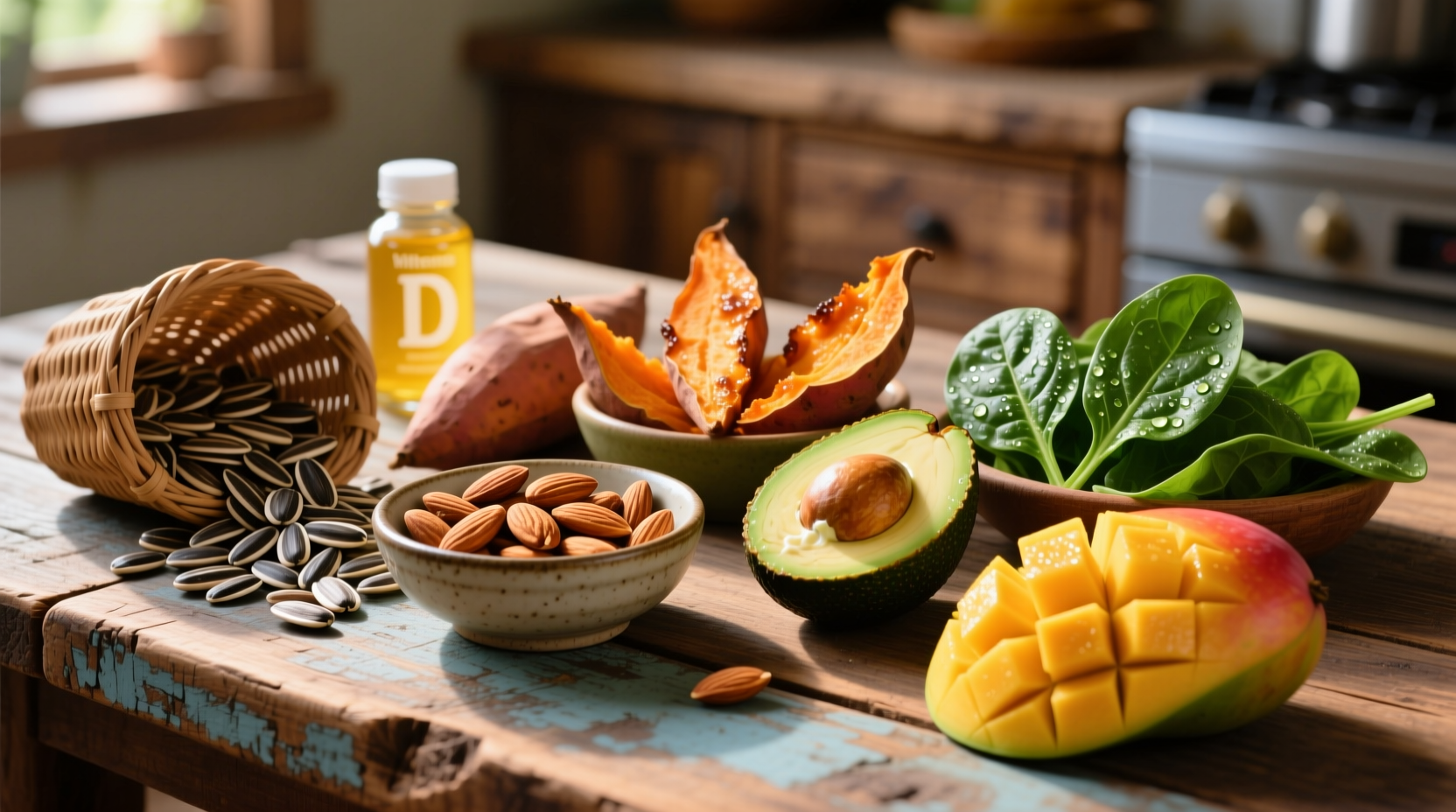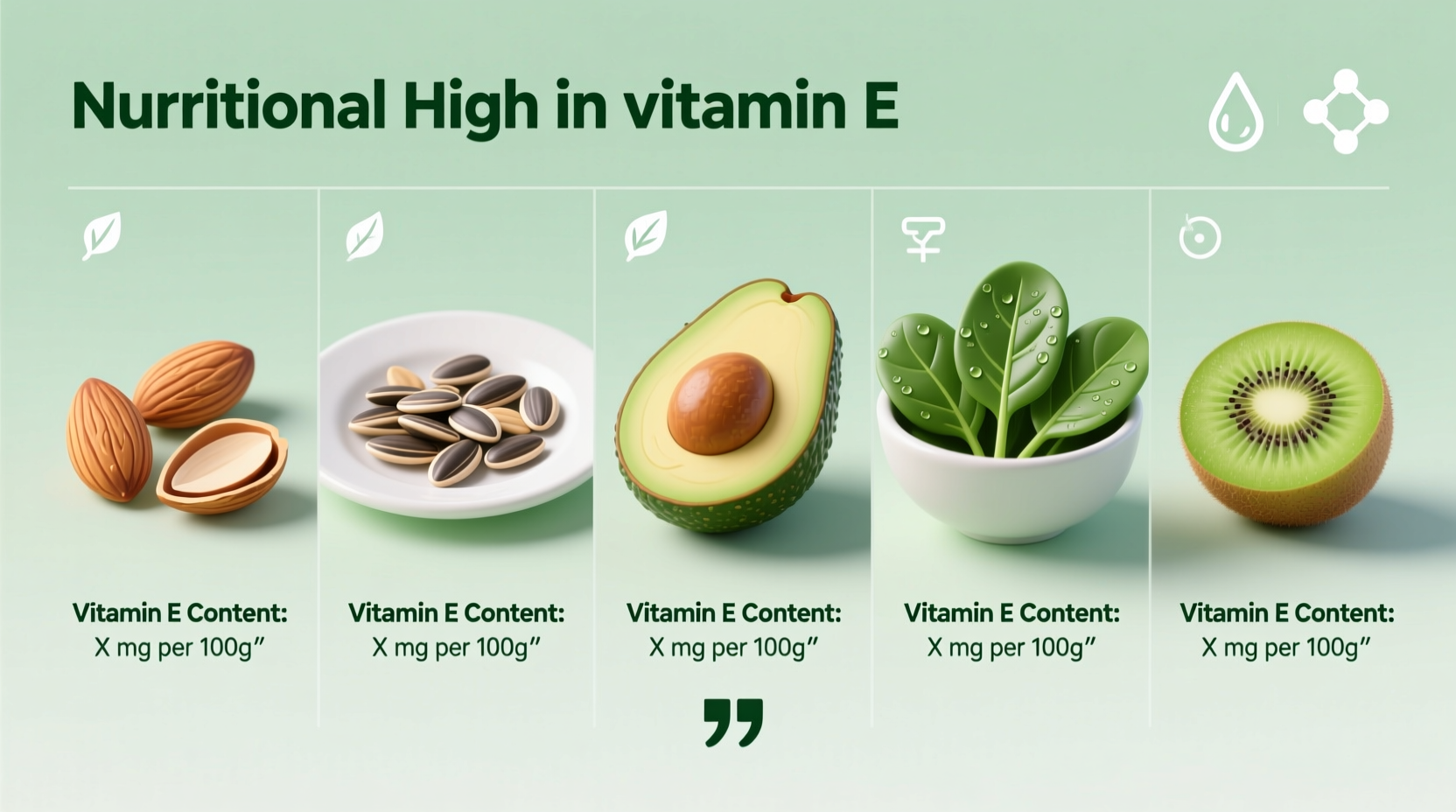Top Vitamin E-Rich Foods: Sunflower seeds (1 oz: 7.4mg), almonds (1 oz: 6.8mg), hazelnuts (1 oz: 4.3mg), and wheat germ oil (1 tbsp: 20.3mg) deliver the highest concentrations of vitamin E. These natural sources provide 30-135% of your daily requirement in single servings, making them essential additions to a balanced diet.
Discover exactly which foods contain the most vitamin E and how to incorporate them into your daily meals for optimal health benefits. This guide provides scientifically verified data on vitamin E content, practical serving suggestions, and evidence-based recommendations to help you meet your nutritional needs through food rather than supplements.
Why Vitamin E Matters for Your Health
Vitamin E serves as a powerful antioxidant that protects your cells from damage caused by free radicals. According to the National Institutes of Health, adequate vitamin E intake supports immune function, prevents blood clotting, and maintains healthy skin and eyes. The recommended daily allowance (RDA) is 15mg for adults, but many Americans fall short of this target.
Unlike supplements, which can sometimes provide excessive amounts that may interact with medications, getting vitamin E from whole foods delivers this essential nutrient alongside other beneficial compounds like fiber, healthy fats, and additional antioxidants. This natural synergy enhances absorption and provides broader health benefits.
Nuts and Seeds: Powerhouses of Vitamin E
Nuts and seeds represent the most concentrated food sources of vitamin E. Their healthy fat content actually enhances vitamin E absorption, making them superior to many other options.
Sunflower seeds lead the category with 7.4mg per ounce (49% of RDA). Just a small handful provides nearly half your daily requirement. Almonds follow closely with 6.8mg per ounce (45% of RDA), while hazelnuts offer 4.3mg per ounce (29% of RDA). Incorporating these into your daily snack routine delivers significant nutritional benefits without excessive calories.
For maximum benefit, choose raw or dry-roasted varieties without added oils or sugars. The vitamin E content remains stable during dry roasting but can degrade when exposed to high-heat oil frying.
Vitamin E in Cooking Oils: Beyond Just Salad Dressings
Certain vegetable oils contain exceptionally high vitamin E concentrations, though their usage requires strategic planning to maximize benefits without excessive calorie intake.
| Oil Type | Vitamin E (per tbsp) | % of Daily Value | Best Usage |
|---|---|---|---|
| Wheat Germ Oil | 20.3mg | 135% | Salad dressings, drizzling |
| Sunflower Oil | 5.6mg | 37% | Light cooking, baking |
| Safflower Oil | 4.6mg | 31% | Salad dressings |
| Grapeseed Oil | 3.9mg | 26% | Light sautéing |
Wheat germ oil stands out with an impressive 20.3mg per tablespoon—more than your entire daily requirement. However, its strong flavor and low smoke point make it unsuitable for high-heat cooking. The USDA FoodData Central database confirms that using wheat germ oil in salad dressings or as a finishing oil preserves both flavor and nutrient content.
Green Vegetables: Unexpected Vitamin E Sources
While not as concentrated as nuts and oils, several green vegetables provide meaningful vitamin E contributions alongside other essential nutrients. These options appeal to those seeking plant-based nutrition without high fat content.
Swiss chard leads with 2.1mg per cooked cup (14% of RDA), followed by turnip greens at 1.7mg per cooked cup (11% of RDA). Spinach provides 1.6mg per cooked cup (11% of RDA), while broccoli delivers 1.1mg per cooked cup (7% of RDA).
The cooking process actually increases vitamin E bioavailability in these vegetables. Steaming or sautéing with a small amount of healthy fat (like olive oil) enhances absorption. Raw consumption still provides benefits but with slightly lower absorption rates.
Practical Integration: Making Vitamin E Part of Your Daily Routine
Successfully incorporating vitamin E-rich foods requires strategic planning that fits your lifestyle. These evidence-based approaches ensure consistent intake without dietary disruption:
- Breakfast boost: Add 1 tablespoon of wheat germ to your morning oatmeal or smoothie (provides 2.4mg)
- Smart snacking: Keep portion-controlled bags of almonds (1 oz = 6.8mg) at work or in your bag
- Salad upgrade: Replace standard dressing with a homemade version using sunflower oil (1 tbsp = 5.6mg)
- Cooking swap: Use hazelnut oil for finishing roasted vegetables instead of standard olive oil
Registered dietitians recommend spreading vitamin E intake throughout the day rather than consuming it all at once. Your body absorbs fat-soluble vitamins like E more effectively when distributed across multiple meals containing some dietary fat.
Special Considerations for Different Dietary Needs
Vitamin E requirements vary based on individual circumstances. Understanding these differences helps tailor your food choices appropriately:
Smokers need approximately 30% more vitamin E than non-smokers due to increased oxidative stress. The American Heart Association notes that smokers metabolize vitamin E faster, creating higher dietary requirements.
Individuals with fat malabsorption conditions (like Crohn's disease or cystic fibrosis) may struggle to absorb vitamin E from food sources. In these cases, medical supervision becomes essential, though whole food sources remain preferable to supplements when possible.
Vegetarians and vegans typically consume more vitamin E than omnivores due to higher nut, seed, and vegetable intake. However, careful planning ensures consistent daily intake across all dietary patterns.
Debunking Common Vitamin E Myths
Several misconceptions about vitamin E persist despite scientific evidence to the contrary. Understanding these helps make informed dietary choices:
Myth: All vegetable oils provide similar vitamin E content.
Fact: Vitamin E concentration varies dramatically between oils. Canola oil contains just 1.6mg per tablespoon compared to wheat germ oil's 20.3mg.
Myth: Cooking destroys all vitamin E in foods.
Fact: While high-heat frying reduces vitamin E, moderate cooking methods like steaming actually increase bioavailability in vegetables.
Myth: Vitamin E supplements are as effective as food sources.
Fact: Research published in the American Journal of Clinical Nutrition shows that natural vitamin E from foods has higher bioavailability and provides additional phytonutrients not found in supplements.

Meeting Your Vitamin E Needs Through Food Alone
For most healthy adults, obtaining adequate vitamin E through diet alone is entirely achievable with strategic food choices. A single day's menu demonstrating this approach might include:
- Morning smoothie with spinach (1.6mg) and sunflower seeds (3.7mg)
- Almond butter on whole grain toast (3.4mg)
- Salad with wheat germ oil dressing (10.1mg)
- Steamed Swiss chard as a side (2.1mg)
This sample menu provides approximately 21mg of vitamin E—well above the recommended 15mg daily requirement. The variety ensures you receive vitamin E alongside other beneficial nutrients without excessive calorie intake.
Remember that vitamin E works synergistically with other nutrients. Consuming vitamin E-rich foods alongside vitamin C sources (like citrus fruits) creates a powerful antioxidant combination that provides greater protection than either nutrient alone.











 浙公网安备
33010002000092号
浙公网安备
33010002000092号 浙B2-20120091-4
浙B2-20120091-4